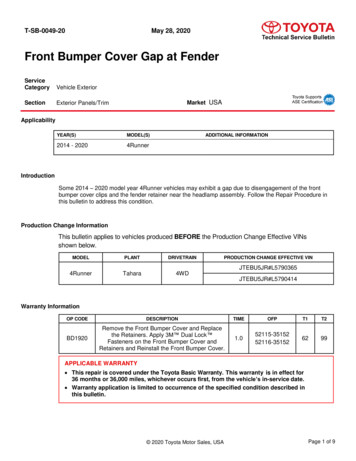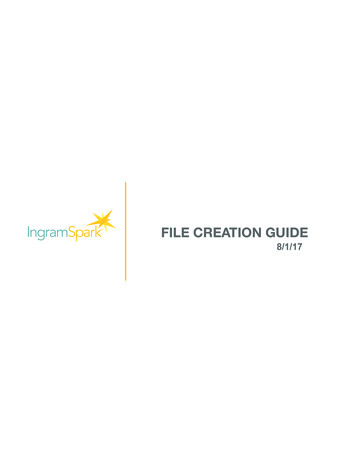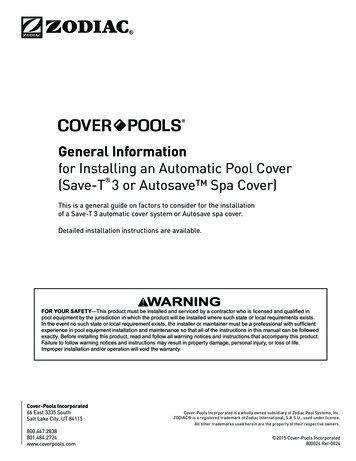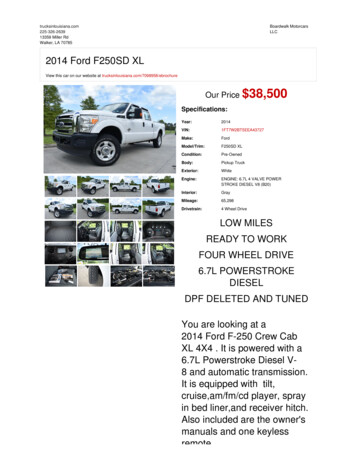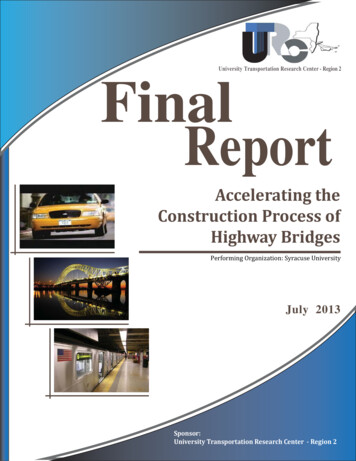
Transcription
University Transportation Research Center - Region 2FinalReportAccelerating theConstruction Process ofHighway BridgesPerforming Organization: Syracuse UniversityJuly 2013Sponsor:University Transportation Research Center - Region 2
University Transportation Research Center - Region 2The Region 2 University Transportation Research Center (UTRC) is one of ten original UniversityTransportation Centers established in 1987 by the U.S. Congress. These Centers were establishedwith the recognition that transportation plays a key role in the nation's economy and the qualityof life of its citizens. University faculty members provide a critical link in resolving our nationaland regional transportation problems while training the professionals who address our transportation systems and their customers on a daily basis.The UTRC was established in order to support research, education and the transfer of technologyin the ield of transportation. The theme of the Center is "Planning and Managing RegionalTransportation Systems in a Changing World." Presently, under the direction of Dr. Camille Kamga,the UTRC represents USDOT Region II, including New York, New Jersey, Puerto Rico and the U.S.Virgin Islands. Functioning as a consortium of twelve major Universities throughout the region,UTRC is located at the CUNY Institute for Transportation Systems at The City College of New York,the lead institution of the consortium. The Center, through its consortium, an Agency-IndustryCouncil and its Director and Staff, supports research, education, and technology transfer under itstheme. UTRC’s three main goals are:ResearchThe research program objectives are (1) to develop a theme based transportation researchprogram that is responsive to the needs of regional transportation organizations and stakeholders, and (2) to conduct that program in cooperation with the partners. The program includes bothstudies that are identi ied with research partners of projects targeted to the theme, and targeted,short-term projects. The program develops competitive proposals, which are evaluated to insurethe mostresponsive UTRC team conducts the work. The research program is responsive to theUTRC theme: “Planning and Managing Regional Transportation Systems in a Changing World.” Thecomplex transportation system of transit and infrastructure, and the rapidly changing environment impacts the nation’s largest city and metropolitan area. The New York/New JerseyMetropolitan has over 19 million people, 600,000 businesses and 9 million workers. The Region’sintermodal and multimodal systems must serve all customers and stakeholders within the regionand globally.Under the current grant, the new research projects and the ongoing research projectsconcentrate the program efforts on the categories of Transportation Systems Performance andInformation Infrastructure to provide needed services to the New Jersey Department of Transportation, New York City Department of Transportation, New York Metropolitan TransportationCouncil , New York State Department of Transportation, and the New York State Energy andResearch Development Authorityand others, all while enhancing the center’s theme.Education and Workforce DevelopmentThe modern professional must combine the technical skills of engineering and planning withknowledge of economics, environmental science, management, inance, and law as well asnegotiation skills, psychology and sociology. And, she/he must be computer literate, wired to theweb, and knowledgeable about advances in information technology. UTRC’s education andtraining efforts provide a multidisciplinary program of course work and experiential learning totrain students and provide advanced training or retraining of practitioners to plan and manageregional transportation systems. UTRC must meet the need to educate the undergraduate andgraduate student with a foundation of transportation fundamentals that allows for solvingcomplex problems in a world much more dynamic than even a decade ago. Simultaneously, thedemand for continuing education is growing – either because of professional license requirementsor because the workplace demands it – and provides the opportunity to combine State of Practiceeducation with tailored ways of delivering content.UTRC-RF Project No: 49111-29-21Project Date: July 2013Project Title: Accelerating the Construction Process ofHighway BridgesProject’s ipal Investigator:Dr. Ossama (Sam) SalemYabroudi Chair Professor of Sustainable Civil Infrastructures151 Link Hall, Civil and Environmental EngineeringDeparement,Syracuse University, Syracuse, NY 13244Tel: 315-443-3401; Fax: 315-443-1243;Email: omsalem@syr.eduCollaboratorsName: Dr. Baris SalmanInstructorR-214 Academic Blocks, Civil Engineering Program,Middle East Technical University – Northern CyprusCampus, Mersin-10, TURKEYTel: 90-392-661-2931; Fax: 90-392-661-2999;Email: bsalman@metu.edu.trName: Dr. Riyad AboutahaAssociate Professor151 Link Hall, Civil and Environmental EngineeringDepartment,Syracuse University, Syracuse, NY 13244Tel: 315-443-3347; Fax: 315-443-1243;Email: rsabouta@syr.eduPerforming Organization: Syracuse UniversitySponsor:University Transportation Research Center - Region 2, ARegional University Transportation Center sponsored bythe U.S. Department of Transportation’s Research andInnovative Technology AdministrationTechnology TransferUTRC’s Technology Transfer Program goes beyond what might be considered “traditional”technology transfer activities. Its main objectives are (1) to increase the awareness and level ofinformation concerning transportation issues facing Region 2; (2) to improve the knowledge baseand approach to problem solving of the region’s transportation workforce, from those operatingthe systems to those at the most senior level of managing the system; and by doing so, to improvethe overall professional capability of the transportation workforce; (3) to stimulate discussion anddebate concerning the integration of new technologies into our culture, our work and ourtransportation systems; (4) to provide the more traditional but extremely important job ofdisseminating research and project reports, studies, analysis and use of tools to the education,research and practicing community both nationally and internationally; and (5) to provideunbiased information and testimony to decision-makers concerning regional transportationissues consistent with the UTRC theme.To request a hard copy of our inal reports, please send us anemail at utrc@utrc2.orgMailing Address:University Transportation Reserch CenterThe City College of New YorkMarshak Hall, Suite 910160 Convent AvenueNew York, NY 10031Tel: 212-650-8051Fax: 212-650-8374Web: www.utrc2.org
Board of DirectorsUTRC Consortium UniversitiesThe UTRC Board of Directors consists of one or two members from eachConsortium school (each school receives two votes regardless of thenumber of representatives on the board). The Center Director is anex-of icio member of the Board and The Center management team servesas staff to the Board.The following universities/colleges are members of the UTRC consortium.City University of New YorkDr. Hongmian Gong - GeographyDr. Neville A. Parker - Civil EngineeringClarkson UniversityDr. Kerop D. Janoyan - Civil EngineeringColumbia UniversityDr. Raimondo Betti - Civil EngineeringDr. Elliott Sclar - Urban and Regional PlanningCornell UniversityDr. Huaizhu (Oliver) Gao - Civil EngineeringDr. Mark A. Turnquist - Civil EngineeringHofstra UniversityDr. Jean-Paul Rodrigue - Global Studies and GeographyManhattan CollegeDr. Anirban De - Civil & Environmental EngineeringDominic Esposito - Research AdministrationNew Jersey Institute of TechnologyDr. Steven Chien - Civil EngineeringDr. Joyoung Lee - Civil & Environmental EngineeringNew York Institute of TechnologyDr. Nada Marie Anid - Engineering & Computing SciencesDr. Marta Panero - Engineering & Computing SciencesNew York UniversityDr. Mitchell L. Moss - Urban Policy and PlanningDr. Rae Zimmerman - Planning and Public AdministrationPolytechnic Institute of NYUDr. John C. Falcocchio - Civil EngineeringDr. Kaan Ozbay - Civil EngineeringRensselaer Polytechnic InstituteDr. José Holguín-Veras - Civil EngineeringDr. William "Al" Wallace - Systems EngineeringRochester Institute of TechnologyDr. J. Scott Hawker - Software EngineeringDr. James Winebrake -Science, Technology, & Society/Public PolicyRowan UniversityDr. Yusuf Mehta - Civil EngineeringDr. Beena Sukumaran - Civil EngineeringRutgers UniversityDr. Robert Noland - Planning and Public PolicyCity University of New York (CUNY)Clarkson University (Clarkson)Columbia University (Columbia)Cornell University (Cornell)Hofstra University (Hofstra)Manhattan CollegeNew Jersey Institute of Technology (NJIT)New York Institute of Technology (NYIT)New York University (NYU)Polytechnic Institute of NYU (Poly)Rensselaer Polytechnic Institute (RPI)Rochester Institute of Technology (RIT)Rowan University (Rowan)Rutgers University (Rutgers)*State University of New York (SUNY)Stevens Institute of Technology (Stevens)Syracuse University (SU)The College of New Jersey (TCNJ)University of Puerto Rico - Mayagüez (UPRM)* Member under SAFETEA-LU LegislationUTRC Key StaffDr. Camille Kamga: Director, UTRCAssistant Professor of Civil Engineering, CCNYDr. Robert E. Paaswell: Director Emeritus of UTRC and DistinguishedProfessor of Civil Engineering, The City College of New YorkHerbert Levinson: UTRC Icon Mentor, Transportation Consultant andProfessor Emeritus of TransportationDr. Ellen Thorson: Senior Research Fellow, University TransportationResearch CenterPenny Eickemeyer: Associate Director for Research, UTRCDr. Alison Conway: Associate Director for New Initiatives and AssistantProfessor of Civil EngineeringNadia Aslam: Assistant Director for Technology TransferDr. Anil Yazici: Post-doc/ Senior ResearcherNathalie Martinez: Research Associate/Budget AnalystState University of New YorkMichael M. Fancher - NanoscienceDr. Catherine T. Lawson - City & Regional PlanningDr. Adel W. Sadek - Transportation Systems EngineeringDr. Shmuel Yahalom - EconomicsStevens Institute of TechnologyDr. Sophia Hassiotis - Civil EngineeringDr. Thomas H. Wakeman III - Civil EngineeringSyracuse UniversityDr. Riyad S. Aboutaha - Civil EngineeringDr. O. Sam Salem - Construction Engineering and ManagementThe College of New JerseyDr. Thomas M. Brennan Jr. - Civil EngineeringUniversity of Puerto Rico - MayagüezDr. Ismael Pagán-Trinidad - Civil EngineeringDr. Didier M. Valdés-Díaz - Civil EngineeringMembership as of January 2014
TECHNICAL REPORT STANDARD TITLE PAGE1. Report No.2.Government Accession No.3. Recipient’s Catalog No.4. Title and Subtitle5. Report DateJuly 2013Accelerating the Construction Process of Highway Bridges6. Performing Organization Code7. Author(s)8. Performing Organization Report No.Dr. Ossama (Sam) Salem, Ph.D., CPC, PE, LEED AP9. Performing Organization Name and Address10. Work Unit No.Department of Civil and Environmental Engineering,Syracuse University,Syracuse, NY- 1324411. Contract or Grant No.49111-29-2112. Sponsoring Agency Name and Address13. Type of Report and Period CoveredUniversity Transportation Research CenterCity College of New York-Marshak 910160 Convent AvenueNewYork, NY 10031Final Report14. Sponsoring Agency Code15. Supplementary Notes16. AbstractFunctional obsolescence and structural deficiencies of highway bridges are posing significant threats to commuters and transportation agenciesthroughout the United States. Recently, New York State Department of Transportation (NYSDOT) classified approximately one quarter of itsbridges as functionally obsolete and one-eighth as structurally deficient. Highway bridges located in urban areas are especially at high risk offunctional obsolescence as the aging highway systems in these areas face significant increases in traffic volumes.As a result of increasing needs associated with upgrades and repairs, the decision makers are urged to determine the best use of limited resources.In addition to mitigating risks that emerge from ordinary operating conditions, agencies also need to determine appropriate methods to reduceimpacts of natural disasters and accidents as part of an emergency response system. Employing traditional construction methods for repair orupgrade activities may cause lengthy traffic disruptions, which results in high user costs and environmental impacts and raises issues of safety andcongestion. Accelerated construction refers to project delivery methods that combine innovative construction techniques and contracting methodsin order to reduce the environmental and socio-economic impacts of construction activities and to reduce the downtime of highway bridges.The objective of this study was to investigate opportunities to reduce the negative impacts of bridge closures due to repair and upgrade activitiesby:1. Exploring various alternative construction materials and methods, such as - use of prefabricated/precast systems, and innovative contractingmethods such as A B bidding, incentive/disincentive contract, and lane rental that can be used to accelerate construction activities of bridges.2. Identifying important factors (both qualitative and quantitative) which affect the decision making procedures for selecting the most appropriateupgrade or repair strategy,3. Providing a decision support framework that will allow evaluation of alternativesIn order to fulfill these objectives, a comprehensive review of the available literature was performed with a focus on accelerated constructionmethods and contracts, factors affecting decision-making procedures for selection of appropriate bridge upgrade and repair methods andcontracting approaches. In addition, a national survey of state DOTs was conducted in order to determine the current state of practice throughoutthe United States.The decision support framework developed in this study consists of Traditional vs. Accelerated Bridge Construction (ABC) Analytical HierarchyProcess (AHP) decision making model as well as flowchart models to select appropriate construction techniques and contracting alternatives. Theframework altogether provides a systematic procedure for comparing various upgrade and repair strategies. Thus, decisions regarding selection ofappropriate upgrade/repair methods and contracting approaches made using the above-mentioned models are expected to be more objective andjustifiable. The models are also validated using several case studies in the state of New York.17. Key Words18. Distribution StatementAccelerated construction techniques, Innovative Contracting,Bidding, Bridges, Analytical Hierarchy Process19. Security Classif (of this report)20. Security Classif. (of this page)UnclassifiedUnclassifiedForm DOT F 1700.7 (8-69)21. No of Pages127 pages22. Price
DisclaimerThe contents of this report reflect the views of the authors, who are responsible for thefacts and the accuracy of the information presented herein. The contents do notnecessarily reflect the official views or policies of the UTRC [, (other project sponsors),]or the Federal Highway Administration. This report does not constitute a standard,specification or regulation. This document is disseminated under the sponsorship of theDepartment of Transportation, University Transportation Centers Program, in the interestof information exchange. The U.S. Government and other project sponsors assume noliability for the contents or use thereof.
Executive SummaryFunctional obsolescence and structural deficiencies of highway bridges are posingsignificant threats to commuters and transportation agencies throughout the United States.Recently, New York State Department of Transportation (NYSDOT) classified approximatelyone quarter of its bridges as functionally obsolete and one-eighth as structurally deficient.Highway bridges located in urban areas are especially at high risk of functional obsolescence asthe aging highway systems in these areas face significant increases in traffic volumes.As a result of increasing needs associated with upgrades and repairs, the decision makersare urged to determine the best use of limited resources. In addition to mitigating risks thatemerge from ordinary operating conditions, agencies also need to determine appropriate methodsto reduce impacts of natural disasters and accidents as part of an emergency response system.Employing traditional construction methods for repair or upgrade activities may cause lengthytraffic disruptions, which results in high user costs and environmental impacts and raises issuesof safety and congestion. Accelerated construction refers to project delivery methods thatcombine innovative construction techniques and contracting methods in order to reduce theenvironmental and socio-economic impacts of construction activities and to reduce the downtimeof highway bridges.The objective of this study is to investigate opportunities to reduce the negative impactsof bridge closures due to repair and upgrade activities by:1. Exploring various alternative construction materials and methods such as use ofprefabricated/precast systems, and innovative contracting methods such as A B bidding,incentive/disincentive contract, and lane rental that can be used to accelerate constructionactivities of bridges,2. Identifying important factors (both qualitative and quantitative) which affect thedecision making procedures for selecting the most appropriate upgrade or repair strategy,3. Providing a decision support framework that will allow evaluation of alternativesIn order to fulfill these objectives, a comprehensive review of the available literature wasperformed with a focus on accelerated construction methods and contracts, factors affectingdecision-making procedures for selection of appropriate bridge upgrade and repair methods andcontracting approaches. In addition, a national survey of state DOTs was conducted in order todetermine the current state of practice throughout the United States.
The decision support framework developed in this study consists of Traditional vs.Accelerated Bridge Construction (ABC) Analytical Hierarchy Process (AHP) decision makingmodel as well as flowchart models to select appropriate construction techniques and contractingalternatives. The framework altogether provides a systematic procedure for comparing variousupgrade and repair strategies. Thus, decisions regarding selection of appropriate upgrade/repairmethods and contracting approaches using the above mentioned models are now more objectiveand justifiable. The models are also validated using several case studies in the state of New York.i
Table of Content1 Introduction . 12 Objective and Methodology . 33 Background Information . 73.1The Need and Definition of Accelerated Construction . 73.2Accelerated Bridge Construction Components . 103.2.1Prefabricated Bridge Elements (PBE) . 113.2.2Prefabricated Bridge Systems (PBS)(Modular Superstructure/ Substructure Systems) . 193.2.3Self-Consolidating /Fast Setting/ High Performance Concrete. 193.3Accelerated Bridge Construction Techniques . 223.3.1Rapid Embankment Construction . 223.3.2Foundation Techniques . 233.3.3Transportation/Lifting/ Placement Techniques . 243.4Traditional Project Delivery. 293.4.13.5Design-Bid-Build (DBB) . 29Alternative Project Delivery . 303.5.1Design Build . 303.5.2Cost-Plus-Time (A B Bidding) . 3223.5.3Lane Rental . 333.5.4Construction Management at Risk (CMR) . 333.5.5Construction Management Agency (CMA) . 343.6Existing Decision Making Models . 363.6.1ABC Decision Making Process (FHWA 2011) . 363.6.22010)Utah Department of Transportation (UDOT) ABC Decision Making Process (UDOT. 423.6.3Framework for Prefabricated Bridge Elements and System Decision Making (Ralls 2006) . 463.6.4Model for evaluating Bridge Construction Plans (El-Diarabi and O' Connor 2001) . 484 Questionnaire Survey . 51ii
4.1General Information . 514.2Project Delivery . 514.3Factors affecting ABC decision making process . 534.4Survey Results . 565 ABC Decision Making Process . 725.1PHASE I. 725.1.1Analytical Hierarchy Process (AHP) (Saaty 1982) . 725.1.2ABC vs. Traditional Decision Making Model using AHP. 775.2Phase II. 875.2.1ABC Techniques Decision Making Model . 875.2.2Project Delivery System Decision Making Model. 896 Case Studies . 906.1Cross Bay over North Channel 87 viaduct:. 906.2Route 31 over Canandaigua Outlet: . 946.3Route 23 Over Otego Creek: . 956.4Route 9 W over Cedar Pond Brook: . 976.5Route 32 over Katerskill Creek:. 996.6Seven Lake Drive/ Ramapo River: . 1006.7A Hypothetical Traditional Construction Project: . 1027 Conclusion . 1048 Recommendations . 1069 References. 107Appendix I: Questionnaire Survey . 112Appendix II: Minutes of the Meeting held on July 2, 2012 atNYSDOT Headquarters, Albany, NY . 122iii
List of AcronymsA/E – Architect EngineerAASHTO – American Association of Transportation and State OfficialsABC – Accelerated Bridge ConstructionABCC – Accelerated Bridge Construction ComponentsACTT - Accelerated Construction Technology TransferAHP – Analytical Hierarchy ProcessAPD – Alternative Project DeliveryCI – Consistency IndexCM – Construction ManagerCMA – Construction Management as AgencyCMR – Construction Management at RiskDB – Design BuildDBB – Design Bid BuildEPS – Expanded PolystyreneFHWA – Federal Highway AdministrationFRP – Fiber Reinforced PolymerFTA - Federal Transit AdministrationGARVEE - Grant Anticipation Revenue VehicleGRS/IBS - Geo-synthetic Reinforced Soil Integrated Bridge SystemHERS - Highway Economic Requirements SystemI/D – Incentive/ DisincentiveISTEA - Intermodal Surface Transportation Efficiency ActLEDB – Low End DB ProjectsMDBP – Mega DB ProjectsMLDB – Mid-Level DB ProjectsNBIAS - National Bridge Investment Analysis SystemNCHRP - National Cooperative Highway Research ProgramNEPA – National Environmental Policy ActNYSDOT – New York State Department of TransportationPBE – Prefabricated ElementsPBES – Prefabricated Bridge Elements and SystemsPBS - Prefabricated SystemsRI – Random IndexROW – Right of WaySCC – Self Consolidating ConcreteSDOT – State DOTSEP - Special Experimental ProjectsSPMT - Self-Propelled Modular TransporterTEA - Transportation Equity Activ
TIFIA - Transportation Finance and Innovation ActTIG – Technology Implementation GroupTRB- Transportation Research BoardTRBNRC - Transportation Research Board National Research CouncilUDC – User Delay CostUDOT – Utah Department of TransportationUHPC – Ultra High Performance ConcreteUSDOT- United States Department of Transportationv
List of FiguresFigure 1: Methodology . 6Figure 2: Accelerated Bridge Construction Components . 10Figure 3: ABC Decision Making Model for Superstructure Construction over Roadway or Land (FHWA2011) . 38Figure 4: ABC Decision Making Model for Superstructure Construction over Railroad or Transits(FHWA 2011) . 39Figure 5: ABC Decision Making Model for Superstructure Construction over Water or Wetlands (FHWA2011) . 40Figure 6: ABC Decision Making Model for Substructure Construction (FHWA 2011) . 41Figure 7: ABC Rating System (UDOT 2010) . 43Figure 8: ABC Rating System (Contd.) (UDOT 2010) . 44Figure 9:ABC Decision Flowchart (UDOT 2010) . 45Figure 10: Flowchart for High Level Decision- Making Process (Ralls 2006) . 47Figure 11: Matrix Questions for High-Level Decision on Whether a Prefabricated Bridge should be usedin a Project (Ralls 2006) . 48Figure 12: Bridge Construction Plan Objective Matrix (El-Diarabi and O' Connor, 2001) . 49Figure 13: Percentage of ABC Projects by State . 57Figure 14: Success Rate of ABC Projects . 59Figure 15: ABC Projects Completed on or ahead of Schedule by State . 60Figure 16: ABC Projects Completed within or below Budget by state . 60Figure 17: ABC Projects Completed within Acceptable Quality and Workmanship by state . 60Figure 18: ABC Projects Completed with NO Accidents by state . 60Figure 19: Average Score of ABC Decision Making Factors. 67Figure 20: Average Score for Challenges/ Hindrance . 69Figure 21: Type of ABC Projects by State .
Mailing Address: University Transportation Reserch Center The City College of New York Marshak Hall, Suite 910 160 Convent Avenue New York, NY 10031 Tel: 212-650-8051 . Hofstra University Dr. Jean-Paul Rodrigue - Global Studies and Geography Manhattan College Dr. Anirban De - Civil & Environmental Engineering .
